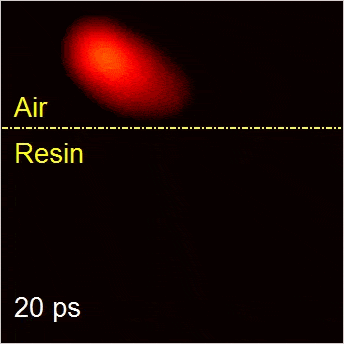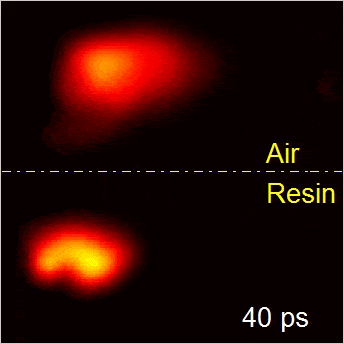High speed photography is no longer a new thing… but then again, it depends what you mean by high speed photography; you likely don’t mean one hundred billion frames per second (100,000,000,000 fps) – but that’s exactly what Liang Gao, Assistant Professor at Stony Brook University means. He and his team have developed the world’s fastest receive-only 2-D camera.

Using the Washington University technique, called compressed ultrafast photography (CUP), Wang and his colleagues have made movies of things we could have previously only imagined: laser pulse reflection, refraction, faster-than light propagation of what is called non-information, and photon racing in two media. You can see all these here.
As a matter of fact, the technology is too advanced – so there are quite some problems with it.
“For the first time, humans can see light pulses on the fly,” Wang says. “Because this technique advances the imaging frame rate by orders of magnitude, we now enter a new regime to open up new visions. Each new technique, especially one of a quantum leap forward, is always followed a number of new discoveries. It’s our hope that CUP will enable new discoveries in science — ones that we can’t even anticipate yet.”

Of course the camera doesn’t look like your average Canon or Nikon – it’s actually a series of devices envisioned to work with high-powered microscopes and telescopes to capture dynamic natural and physical phenomena. The raw data is gathered, sent to a computer, and only there does the image form – this is called computational imaging.
“These ultrafast cameras have the potential to greatly enhance our understanding of very fast biological interactions and chemical processes and allow us to build better models of complex, dynamical systems.” said Richard Conroy, PhD, program director of optical imaging at the National Institute of Biomedical Imaging and Bioengineering.
Indeed, aside for being incredibly cool, this camera also has many potential applications; the most obvious ones are in biomedicine, which is actually what the team had in mind. For example, scientists can detect extremely subtle changes in cellular environmental conditions like pH or oxygen pressure. The technique could also be applied to astronomy, where scientists could analyze the temporal activities of a supernova that occurred many light years away, and in forensics – for bullet trajectory analysis.

“Combine CUP imaging with the Hubble Telescope, and we will have both the sharpest spatial resolution of the Hubble and the highest temporal solution with CUP,” he says. “That combination is bound to discover new science.”
Another special area of application could be fluorescence – the emission of light by a substance that has previously absorbed light; one of the movies researchers published shows a green excitation light pulsing toward fluorescent molecules on the right where the green converts to red, which is the fluorescence. Wang explains why this is important:

“Fluorescence is an important aspect of biological technologies,” he says. “We can use CUP to image the lifetimes of various fluorophores, including fluorescent proteins, at light speed.”
Journal Reference:
- Liang Gao, Jinyang Liang, Chiye Li, Lihong V. Wang. Single-shot compressed ultrafast photography at one hundred billion frames per second. Nature, 2014; 516 (7529): 74 DOI: 10.1038/nature14005. *note: as we were telling you a few days ago, you can now freely access all the articles on Nature for free!


